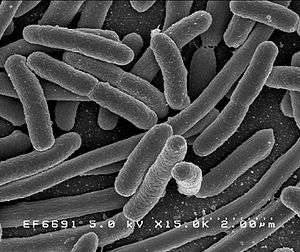Blackwater (waste)
Blackwater is used to describe wastewater containing feces, urine and flushwater from flush toilets along with anal cleansing water (if water is used for cleansing) or toilet paper.[1] It is distinct from greywater or sullage, the wastewater generated from washing food, clothes and dishware, as well as from bathing, but not from toilets.[1]
In practice
Water coming from domestic equipment other than toilets (e.g., bathtubs, showers, sinks, washing machines) is called greywater and it is preferred to be kept separate from blackwater (which comes from toilets) to reduce the amount of water that gets heavily polluted.
Separation of blackwater and greywater nowadays happens with all ecological buildings. Especially in autonomous buildings, the separation is always present. It is also commonly used on recreational vehicles which feature a greywater holding tank and a blackwater holding tank.
Blackwater is a term dating to at least the 1970s[2]
Processing
Blackwater contains pathogens that must decompose before they can be released safely into the environment. It is difficult to process blackwater if it contains a large quantity of excess water, or if it must be processed quickly, because of the high concentrations of organic material. However, if blackwater does not contain excess water, or if it receives primary treatment to de-water, then it is easily processed through composting. The heat produced by naturally occurring thermophilic microorganisms, will heat the compost to over 60 °C (140 °F), and destroy potential pathogens. The compost is eventually reduced to safe fertilizer after about 1 year.[3]
Elimination
Blackwater can be avoided by making use of composting toilets and vermicomposting toilets. In certain autonomous buildings, such as earthships, this is almost always \resent and allows the water requirements of the building (which, with earthships, are self-generated) to be heavily reduced. Besides saving water, composting toilets allow the user to reuse the nutrients found therein (e.g., for growing crops/trees).
See also
References
- 1 2 Tilley, E.; Ulrich, L.; Lüthi, C.; Reymond, Ph.; Zurbrügg, C. Compendium of Sanitation Systems and Technologies - (2nd Revised Edition). Swiss Federal Institute of Aquatic Science and Technology (Eawag), Duebendorf, Switzerland. p. 10. ISBN 978-3-906484-57-0.
- ↑ US Patent 3915857, issued in October 1975
- ↑ weblife.org: Humanure Handbook: Contents
- ↑ Use of blackwater to make chemical fertilizer
- ↑ Algae fuel production from blackwater
